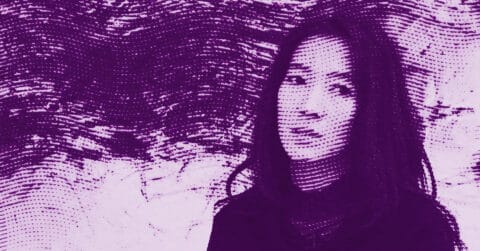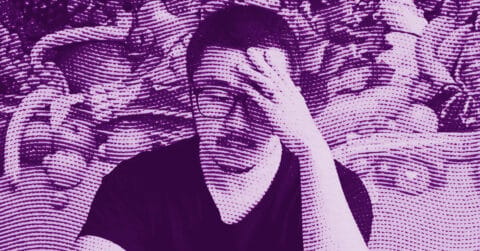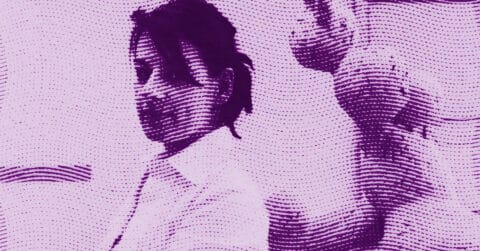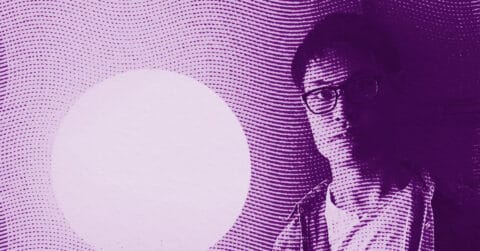Listen to me carefully, you bunch of snobs: Marlene Dumas does not paint portraits, she scours the human soul with a surgical precision that should keep you awake at night. Born in 1953 in Cape Town, this South African based in Amsterdam since 1976 has built a body of work that systematically refuses to comfort us in our aesthetic certainties. Where you seek beauty, she serves you the truth, and truth, my dear friends, is never pretty to look at.
The artist works from secondhand images, magazine photographs, pornographic shots, or friends’ polaroids, which she subjects to a radical metamorphosis. Her liquid brushstrokes, wet-on-wet technique, and unlikely colors create faces that seem to dissolve before our eyes. These figures do not represent individuals but emotional states, psychic tensions, and contained violences. This is what distinguishes Dumas from the cohort of contemporary portraitists: she does not seek to capture a likeness but to reveal what boils beneath the polished surface of humanity.
Her relationship with Baudelairean poetry deserves prolonged attention because it sheds a particularly vivid light on the artist’s approach. In 2021, the Musée d’Orsay celebrated the bicentenary of Charles Baudelaire’s birth by inviting Dumas to create a series inspired by the Spleen of Paris [1]. This posthumous collaboration between two minds equally enamored with the beauty of the terrible was no mere anecdote. Baudelaire, the poet who saw modernity as an inextricable mix of splendor and misery, finds in Dumas a spiritual heir who shares his obsession with the ambivalence of the beautiful.
The fourteen paintings born from this project show Dumas at the height of her art, navigating between precisely executed portraits of the poet and his mistress Jeanne Duval, and more abstract representations of motifs taken from the poems, the rat, the bottle, the poor man’s toy. Just as Baudelaire described in his prose poems the paradoxes of a society caught between progress and decadence, Dumas paints the contradictions of a humanity that simultaneously bears innocence and cruelty. The artist herself confessed the difficulty of this undertaking, seeking to “paint a portrait of a man that shows something of all this, in his face” in the face of the “contradictory emotions and poetic leaps” of the Baudelairean text [2].
This kinship with the poet of the Fleurs du mal is rooted in a shared vision of art as a revealer of disturbing truths. Where Baudelaire denounced “the stupidity and vanity of idle ladies and so-called gentlemen,” Dumas dismantles the power mechanisms hidden behind every representation. Her paintings inspired by Le Spleen de Paris are not mere illustrations; they constitute a pictorial response to the poet’s questioning of the modern human condition. The face of Baudelaire she paints twice appears spectral, almost erased, as if the poet continues from beyond to cast his ruthless gaze upon our collective souls.
The series created for the Musée d’Orsay particularly explores the theme of solitude and despair that runs through Baudelaire’s work. In Le Désespoir de la vieille, Dumas depicts a woman almost entirely erased by black pigment, curled up in a corner, an image of such absolute distress that it becomes almost abstract. This ability to condense poetic emotion into pure visual sensation brings Dumas close to the Baudelairean aesthetic where the ugly and the beautiful, the sublime and the abject coexist in a productive tension. The poet wrote that art should extract beauty from evil; Dumas, however, asserts that “there is no beauty if it does not show a part of life’s horror” [3].
This affinity with Baudelaire also reveals the importance of literature in Dumas’ creative process. Her work is nourished by “passionate and fragmentary” readings of poetry and literature. She does not seek to illustrate texts but to establish a dialogue with them where painting and words enrich each other mutually. Her canvases become spaces where echoes of other voices, other eras resonate, creating a polyphony that refuses simple contemplation to demand the intellectual and emotional engagement of the viewer.
The psychoanalytic dimension of her work constitutes the second pillar of her artistic approach, and it is no coincidence that Dumas studied psychology at the University of Amsterdam between 1978 and 1980. This training deeply marked her way of approaching portraiture, which she conceives less as a physical representation than as a map of unconscious territories. Her paintings function as analytical sessions where the repressed rises to the surface, where social masks crack to reveal what we would prefer to keep hidden.
Dumas is particularly interested in the troubled zones of the human psyche: sexuality in its rawest manifestations, the latent violence that sleeps within everyone, the guilt inherited from oppressive social structures. Her childhood under apartheid in South Africa nourished permanent reflection on the psychological mechanisms of domination and exclusion. Works like Evil is Banal (1984), where she depicts herself with a blackened face and hand, question her own complicity as a white woman in a racist system. This ability to turn the analytical scalpel against herself testifies to a rare intellectual honesty.
The question of sexual identity and the representation of desire also runs through her work with particular intensity. Dumas paints nudes that have nothing of conventional eroticism; these are bodies exposed in their vulnerability, strangeness, and potential threat. She often works from pornographic material which she subverts to create images that oscillate between revelation and concealment, between exhibition and modesty. This ambivalence reflects the tensions inherent in human sexuality, that mixture of drive and censorship that Freud placed at the heart of the unconscious.
Her portraits of children, notably those of her own daughter Helena, disturb by their refusal of sentimentality. The babies she paints often appear greenish, almost monstrous, as in Die Baba (1985) where the child with features evoking Hitler poses the unbearable question: at what moment does innocence tip into cruelty? These images challenge our need to see childhood as a state of grace, forcing us to recognize that violence and destructiveness are also components of the human condition from the earliest age.
Dumas’s relationship to photographic images that she uses as primary material also reveals a keen understanding of the psychic mechanisms of projection and identification. She never slavishly copies her sources; she subjects them to a process of distancing that allows the artist’s unconscious to infiltrate the representation. This method echoes theories about the fantasy screen, that surface onto which our desires and anxieties are projected. The faces she paints thus become distorting mirrors where we recognize something of ourselves, even, and especially, when the image disgusts us.
The series Models (1994) or the portrait of Naomi Campbell (1995) question the mechanisms of identity construction through the gaze of the other. In painting these beauty icons, Dumas does not celebrate their glamour but reveals the symbolic violence that constitutes them as objects of male desire. Her liquid brushstrokes literally make the faces run, as if identity itself were a precarious construction, always threatened with dissolution. This fundamental instability of the image of the self resonates deeply with psychoanalytic conceptions of the subject as fundamentally divided, fragmented, in perpetual reconstruction.
Her portraits of controversial political figures, such as that of Osama bin Laden (2010), push even further this investigation of the shadowy areas of the collective psyche. By humanizing the terrorist, Dumas does not glorify violence but confronts us with a disturbing truth: the monster resembles us. This ability to reject the ease of manicheanism, to explore the common humanity that persists even in the most repulsive figures, testifies to an analytical depth that far exceeds the simple pictorial exercise.
The question of gaze and recognition, central in psychoanalytic theories on the formation of the subject, runs throughout Dumas’s work. Her figures often fix us with a disturbing intensity, turning us into complicit voyeurs. This play of seeing and being seen, this dialectic of the gaze that constitutes the subject while threatening it, structures the relationship that Dumas establishes between the work and the viewer. We cannot passively contemplate her paintings; they implicate us, accuse us, force us to recognize our own involvement in the structures of power and desire that she represents.
Dumas’s work on the representation of bodies, whether nudes, portraits, or erotic scenes, systematically refuses idealization. Her characters bear the scars of their psychic history: distress is read in the distortion of features, violence in the thickening of pictorial matter, desire in the fluidity of colors that bleed beyond the contours. This very materiality of painting becomes the vehicle for an exploration of the materiality of the body and the unconscious that inhabits it.
Her wet-on-wet technique, where colors mingle and contaminate each other, functions as a metaphor for psychic processes themselves. Nothing is fixed; everything flows, transforms, escapes control. This liquidity of the image reflects the fluidity of the unconscious as conceived by psychoanalysis: a continuous flow of associations, condensations, displacements that defy any attempt at definitive fixation.
The influence she acknowledges from artists such as Edvard Munch or Francis Bacon is not accidental. These painters shared with her an obsession for the visual manifestations of psychic distress, for those moments when interiority overflows onto appearance and distorts the visible. But whereas Bacon enclosed his figures in architectural cages and Munch immersed them in expressionist landscapes, Dumas prefers to isolate them against neutral backgrounds, concentrating all emotional intensity in the treatment of the face and body themselves.
What strikes in her entire body of work is the absolute refusal of consolation. Dumas offers us no comfort, no escape from the truths she reveals. Her paintings function as symptoms in the psychoanalytic sense of the term: they reveal what must remain hidden, they return the repressed in a disguised but recognizable form. This symptomatic dimension of her art perhaps explains the discomfort it often provokes; we are confronted with aspects of ourselves and our society that we would rather ignore.
As we reach the end of this reflection, it appears that Marlene Dumas’s work defies any attempt at convenient classification. She is neither simply a portraitist, nor an expressionist, nor a neo-romantic; she is all of these at once and none entirely. Her art functions like a broken mirror that reflects fragments of truth impossible to recompose into a harmonious whole. This very fragmentation may constitute her most precious contribution: in an era saturated with smoothed images and formatted representations, Dumas reminds us that the human is fundamentally irreproducible, irreducible, and elusive.
Her ability to unite in a single approach the heritage of great European poetry and the insights of psychoanalytic thought on the depths of the human psyche makes her much more than a mere contemporary artist. She positions herself as an archaeologist of the soul, a cartographer of inner territories we dare not explore. Her canvases do not decorate walls; they pierce them, creating dizzying openings onto abysses we would prefer not to contemplate.
The honor bestowed upon her by the Musée d’Orsay in 2021, making her the first living artist to exhibit in the Impressionist gallery, implicitly recognizes this exceptional stature. But beyond institutional recognition, the true value of her works lies in the discomfort they provoke. For art that simply pleases us is merely entertainment; the art that deeply disturbs us is the only one worth lingering on. Marlene Dumas does not create to please; she creates to awaken, to disturb, to force us to think and feel what we would prefer to avoid.
In this era where images proliferate to insignificance, where everything is consumed and forgotten at the speed of the internet connection, Dumas’s work reminds us that some images resist, insist, come back to haunt us. Her portraits are among those one cannot forget precisely because they do not leave us in peace. They continue to work within us long after we have left them, like splinters planted in consciousness, like unanswered questions that pursue us in sleep.
This is, ultimately, the distinctive mark of great art: not that it amazes us in the moment, any well-crafted spectacle can achieve that, but that it continues to operate within us, that it changes our perspective on the world and on ourselves. Marlene Dumas paints faces, certainly, but in doing so, she reshapes ours. She forces us to see ourselves as we did not want to see ourselves, and that is precisely why her work will endure when so many others have faded into oblivion. Beauty, she said, does not exist without showing the horror of life. And we, unwilling spectators of our own decay, can only agree when faced with her paintings that hold up this relentless mirror to us: yes, it is indeed us, in all our miserable splendor, that you have painted.
- Exhibition “Marlene Dumas: The Spleen of Paris”, Musée d’Orsay, Paris, October 12, 2021 – January 30, 2022, project conceived in collaboration with Donatien Grau
- Interview with Marlene Dumas, Artnet News, November 2021
- Marlene Dumas, Sweet Nothings: Notes and Texts, 1982-2014, D.A.P., 2014
















